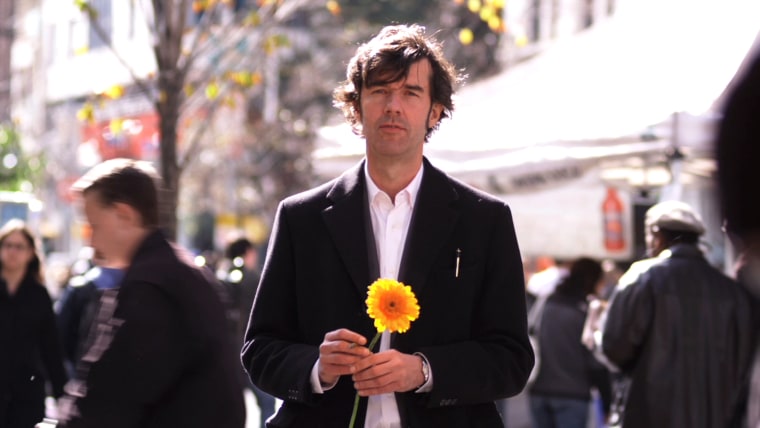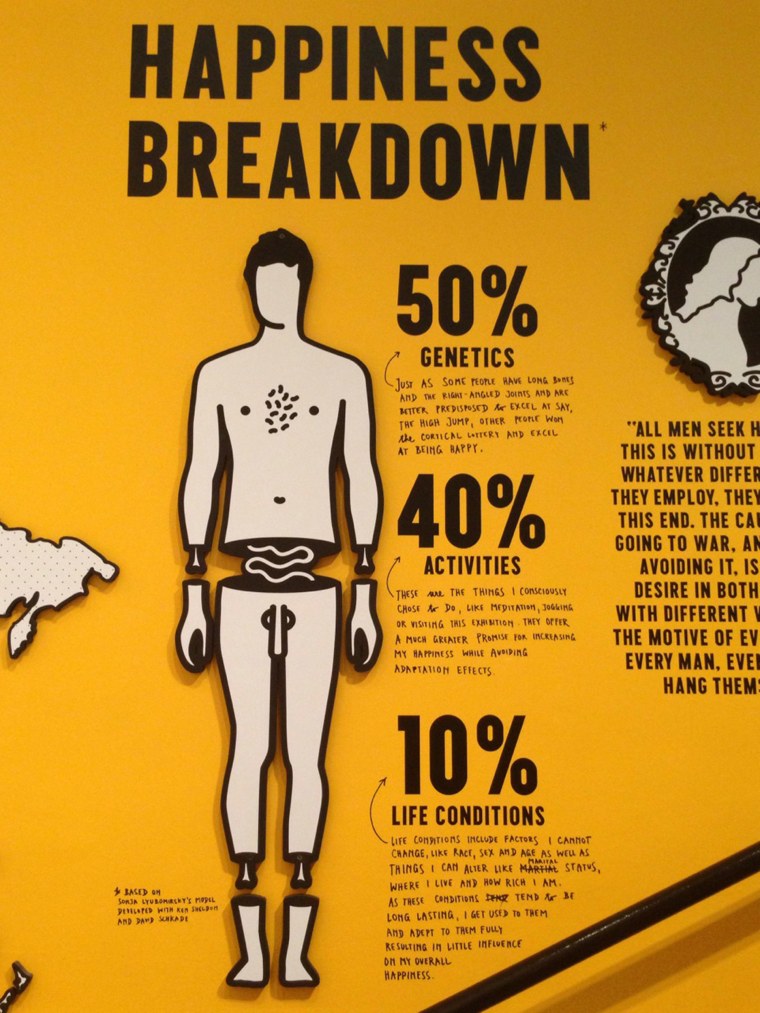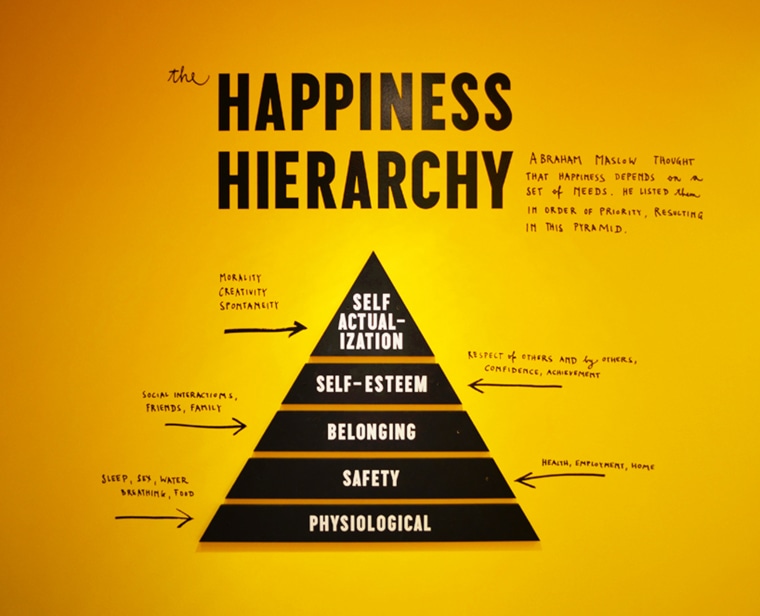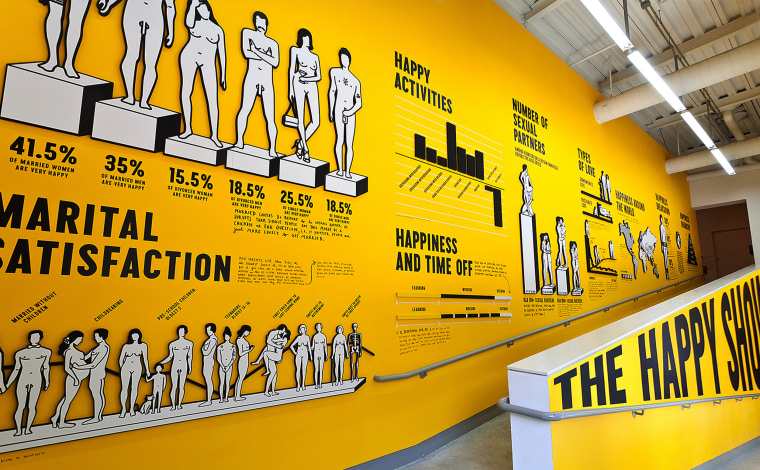What does it take to be happy — to escape life’s ennui, low-level sorrow or what Freud called the “worried well?”
Can you consciously make yourself happy?
Probably not, experts say. But understanding your biological makeup, how you perceive the world and your relationships with others can help to boost happiness.
Stefan Sagmeister, a New York City-based graphic artist who created album covers for the Rolling Stones, Jay-Z and the Talking Heads, set out to see if he could orchestrate his own happiness.
His quest, which was in many ways a failure, is the subject of his first documentary with Ben Nabors, “The Happy Film,” which premieres at the Tribeca Film Festival this weekend and goes on to international festivals.

“Ultimately, we have a conscious and unconscious mind,” Sagmeister, 52, told TODAY. “The unconscious mind is a big elephant and the conscious mind is a tiny rider who thinks he can tell the elephant what to do. But in real life, the sub-conscious mind has its own ideas and direction.”
Watch the trailer for "The Happy Film"
“Only through training can we make the two work together," he said. "And it doesn’t happen overnight.”
Sagmeister is highly successful and had every reason to be happy, but he became easily bored with creative projects when they were not new, and with women after passion waned.
RELATED: Being married helps cancer patients, especially men, live longer
So what was missing in his life?
Jonathan Haidt, a social psychologist from New York University and author of “The Happiness Hypothesis,” says humans are complex creatures who “survive and thrive” in an intensely social world.
“True happiness comes when you get three kinds of relationships right,” he told TODAY. “The one between yourself and others, between yourself and work or something productive and between yourself and something larger than yourself.”

As for love, passion usually ends in about six months, but the joys of companionship rise. He also advises finding a sense of fun and playfulness in life.
Before embarking on his experiment, Sagmeister consulted Haidt, who recommended three scientifically valid approaches to curbing his relationship anxiety — meditation, cognitive therapy and SSRI antidepressants. He also graded his happiness level.
SSRIs are highly effective, according to many studies, though some skeptics say they are no better than a placebo. Drugs may be the “easiest” route, according to Haidt, but there are side effects, such as weight gain and reduced sex drive.
RELATED: How to say you're sorry and sound like you mean it
Meditation can bring the highest satisfaction, but is the most difficult because it requires discipline to stick with it, he said.
Cognitive therapy is highly effective in retraining the brain to stop repetitive thinking and there are zero side effects.

Sagmeister said all three were “solid strategies” but none worked completely.
Haidt, who uses the “elephant and rider” theory in his book, says people can’t just think their way into happiness. The unconscious elephant will always prevail.
“[If ] you have ever achieved … dramatic insights in your own life and resolved to change your ways or your outlook, you probably found that, three months later, you were right back where you started,” he said.
Sagemeister found he was not successful in love relationships: He broke up with three women during each phase of his experiments.

But with the completion of his first film, he says his happiness level is the highest it has ever been — an average of 7.6 out of 10 on his self-assessment log.
Sagmeister spends more time with colleagues and close friends, and he keeps three daily habits that have boosted his happiness quotient:
1. 20 minutes of exercise, usually running. “It’s better than 40 minutes of meditation,” he said. “I can tell if I exercised in the morning by how I will feel at 2 in the afternoon.”
2. Before bed, write down three positive things that worked that day. “Like my line at the post office moved faster, or things I did right.”
3. Praise someone daily. “When I open my email in the morning, I choose whoever wrote me the best one and write back.”
“All three things work, and they are pretty easy to do," he said. "And I don’t have to uproot my life.”
There were some other “super surprises,” too, said Sagmeister. “I discovered how similar I was to other people. My impression of how special I am was much higher before. I used to take things for granted.”
- Diagnose yourself: Everyone has a different biological disposition. You can take the personality test here.
- Improve your mental hygiene. If you tend to “ruminate” on things, you might need cognitive therapy or the benefit of medication.
- Improve your relatedness in love, friendship and with family. Ask yourself the “deathbed question” how you had wished you spent your life.
- Improve your work: Is it a job, a career or a calling?
- Improve your connection to something larger than yourself, whether it be religion, teaching, science or political campaigns.